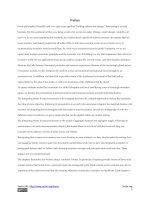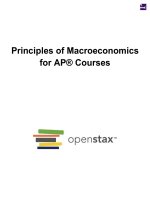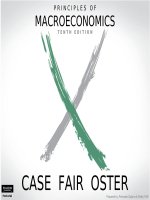Principles of macroeconomics 10e by case fair oster ch18
Bạn đang xem bản rút gọn của tài liệu. Xem và tải ngay bản đầy đủ của tài liệu tại đây (764.87 KB, 39 trang )
PRINCIPLES OF
MACROECONOMICS
PART IV Further Macroeconomics Issues
TENTH
EDITION
CASE FAIR OSTER
© 2012 Pearson Education, Inc. Publishing as Prentice Hall
Prepared by: Fernando Quijano & Shelly
1 ofTefft
23
PART IV Further Macroeconomics Issues
© 2012 Pearson Education, Inc. Publishing as Prentice Hall
2 of 39
Alternative Views in
Macroeconomics
18
CHAPTER OUTLINE
Keynesian Economics
Monetarism
The Velocity of Money
The Quantity Theory of Money
Inflation as a Purely Monetary Phenomenon
The Keynesian/Monetarist Debate
Supply-Side Economics
PART IV Further Macroeconomics Issues
The Laffer Curve
Evaluating Supply-Side Economics
© 2012 Pearson Education, Inc. Publishing as Prentice Hall
New Classical Macroeconomics
The Development of New Classical Macroeconomics
Rational Expectations
Real Business Cycle Theory and New Keynesian Economics
Evaluating the Rational Expectations Assumption
Testing Alternative Macroeconomic Models
3 of 39
Keynesian Economics
In one sense, Keynesian economics is the foundation of all of macroeconomics.
Now used more narrowly, Keynesian sometimes refers to economists who
advocate active government intervention in the macroeconomy.
PART IV Further Macroeconomics Issues
We begin with an old debate—that between Keynesians and monetarists.
© 2012 Pearson Education, Inc. Publishing as Prentice Hall
4 of 39
Monetarism
The debate between monetarist and Keynesian economics is complicated
because it means different things to different people.
If we consider the main monetarist message to be that “money matters,” then
almost all economists would agree.
PART IV Further Macroeconomics Issues
Monetarism, however, is usually considered to go beyond the notion that money
matters.
© 2012 Pearson Education, Inc. Publishing as Prentice Hall
5 of 39
PART IV Further Macroeconomics Issues
In the model of aggregate supply and aggregate demand, money
matters because:
a.
Changes in the money supply affect the AD curve.
b.
Changes in the money supply shifts affect the AS curve in the
short run.
c.
Changes in the money supply shifts affect the AS curve in the
long run.
d.
All of the above.
© 2012 Pearson Education, Inc. Publishing as Prentice Hall
6 of 39
PART IV Further Macroeconomics Issues
In the model of aggregate supply and aggregate demand, money
matters because:
a.
Changes in the money supply affect the AD curve.
b.
Changes in the money supply shifts affect the AS curve in the
short run.
c.
Changes in the money supply shifts affect the AS curve in the
long run.
d.
All of the above.
© 2012 Pearson Education, Inc. Publishing as Prentice Hall
7 of 39
Monetarism
The Velocity of Money
velocity of money The number of times a dollar
bill changes hands, on average, during a year;
the ratio of nominal GDP to the stock of money.
PART IV Further Macroeconomics Issues
The income velocity of money (V) is the ratio of nominal GDP to the
stock of money (M):
© 2012 Pearson Education, Inc. Publishing as Prentice Hall
V≡
GDP
M
8 of 39
Monetarism
The Velocity of Money
We can expand this definition slightly by noting that nominal income
(GDP) is equal to real output (income) (Y) times the overall price level (P):
GDP ≡ P × Y
PART IV Further Macroeconomics Issues
Through substitution:
P ×Y
V≡
M
or
M ×V ≡ P × Y
quantity theory of money The theory based on the identity M × V ≡ P × Y and
the assumption that the velocity of money (V) is constant (or virtually constant).
© 2012 Pearson Education, Inc. Publishing as Prentice Hall
9 of 39
Monetarism
The Quantity Theory of Money
The key assumption of the quantity theory of money is that the
velocity of money is constant (or virtually constant) over time. If we
let V denote the constant value of V, the equation for the quantity
theory can be written as follows:
PART IV Further Macroeconomics Issues
M ×V = P × Y
© 2012 Pearson Education, Inc. Publishing as Prentice Hall
10 of 39
Monetarism
The Quantity Theory of Money
PART IV Further Macroeconomics Issues
Testing the Quantity Theory of Money
FIGURE 18.1 The Velocity of Money, 1960 I–2010 I
Velocity has not been constant over the period from 1960 to 2010.
There is a long-term trend—velocity has been rising.
There are also fluctuations, some of them quite large.
© 2012 Pearson Education, Inc. Publishing as Prentice Hall
11 of 39
Monetarism
Inflation as a Purely Monetary Phenomenon
In the “strict monetarist” view, changes in M affect only P and not Y, so
inflation (an increase in P) is always a purely monetary phenomenon.
The price level will not change if the money supply does not change.
PART IV Further Macroeconomics Issues
There is considerable disagreement as to whether the strict monetarist
view is a good approximation of reality.
Almost all economists agree, however, that sustained inflation—
inflation that continues over many periods—is a purely monetary
phenomenon.
Inflation cannot continue indefinitely without increases in the money
supply.
© 2012 Pearson Education, Inc. Publishing as Prentice Hall
12 of 39
PART IV Further Macroeconomics Issues
The “strict monetarist” view states that:
a.
Changes in aggregate demand cause an increase in both
aggregate income and the price level.
b.
Inflation is a real phenomenon, not a purely monetary
phenomenon.
c.
Changes in the money supply affect only the price level (P), not
real output (Y).
d.
Since velocity is constant, a change in M affects both P and Y.
© 2012 Pearson Education, Inc. Publishing as Prentice Hall
13 of 39
PART IV Further Macroeconomics Issues
The “strict monetarist” view states that:
a.
Changes in aggregate demand cause an increase in both
aggregate income and the price level.
b.
Inflation is a real phenomenon, not a purely monetary
phenomenon.
c.
Changes in the money supply affect only the price level (P),
not real output (Y).
d.
Since velocity is constant, a change in M affects both P and Y.
© 2012 Pearson Education, Inc. Publishing as Prentice Hall
14 of 39
Monetarism
The Keynesian/Monetarist Debate
Monetarists were skeptical of the Fed’s ability to “manage” the
economy—to expand the money supply during bad times and contract
it during good times.
PART IV Further Macroeconomics Issues
The leading spokesman for monetarism, Milton Friedman, advocated a
policy of steady and slow money growth—specifically, that the money
supply should grow at a rate equal to the average growth of real output
(income) (Y).
While not all Keynesians advocated an activist federal government,
many advocated the application of coordinated monetary and fiscal
policy tools to reduce instability in the economy—to fight inflation and
unemployment.
The debate between Keynesians and monetarists subsided with the
advent of what we will call “new classical macroeconomics.”
© 2012 Pearson Education, Inc. Publishing as Prentice Hall
15 of 39
PART IV Further Macroeconomics Issues
Most monetarists, including Milton Friedman, blame most of the
instability in the economy on:
a.
The volatility of investment spending.
b.
Changes in aggregate demand.
c.
Changes in aggregate supply.
d.
The federal government.
© 2012 Pearson Education, Inc. Publishing as Prentice Hall
16 of 39
PART IV Further Macroeconomics Issues
Most monetarists, including Milton Friedman, blame most of the
instability in the economy on:
a.
The volatility of investment spending.
b.
Changes in aggregate demand.
c.
Changes in aggregate supply.
d.
The federal government.
© 2012 Pearson Education, Inc. Publishing as Prentice Hall
17 of 39
Supply-Side Economics
The theories we have been discussing are “demand-oriented.” Supply-side
economics, as the name suggests, focuses on the supply side.
In the late 1970s and early 1980s, supply-siders argued that the real problem
with the economy was not demand, but high rates of taxation and heavy
regulation that reduced the incentive to work, to save, and to invest. What was
needed was not a demand stimulus, but better incentives to stimulate supply.
PART IV Further Macroeconomics Issues
At their most extreme, supply-siders argued that the incentive effects of supplyside policies were likely to be so great that a major cut in tax rates would
actually increase tax revenues.
Even though tax rates would be lower, more people would be working and
earning income and firms would earn more profits, so that the increases in the
tax bases (profits, sales, and income) would then outweigh the decreases in
rates, resulting in increased government revenues.
© 2012 Pearson Education, Inc. Publishing as Prentice Hall
18 of 39
Supply-Side Economics
The Laffer Curve
PART IV Further Macroeconomics Issues
FIGURE 18.2 The Laffer Curve
The Laffer curve shows that
the amount of revenue the
government collects is a
function of the tax rate.
It shows that when tax rates
are very high, an increase in
the tax rate could cause tax
revenues to fall.
Similarly, under the same
circumstances, a cut in the tax
rate could generate enough
additional economic activity to
cause revenues to rise.
Laffer curve With the tax rate measured on the vertical axis and tax
revenue measured on the horizontal axis, the Laffer curve shows that
there is some tax rate beyond which the supply response is large enough
to lead to a decrease in tax revenue for further increases in the tax rate.
© 2012 Pearson Education, Inc. Publishing as Prentice Hall
19 of 39
PART IV Further Macroeconomics Issues
Refer to the figure below. At which point should tax rates be cut?
a.
b.
c.
d.
At point A.
At point B.
At both points A and B.
At neither point A nor B.
© 2012 Pearson Education, Inc. Publishing as Prentice Hall
20 of 39
PART IV Further Macroeconomics Issues
Refer to the figure below. At which point should tax rates be cut?
a.
b.
c.
d.
At point A.
At point B.
At both points A and B.
At neither point A nor B.
© 2012 Pearson Education, Inc. Publishing as Prentice Hall
21 of 39
Supply-Side Economics
Evaluating Supply-Side Economics
Among the criticisms of supply-side economics is that it is unlikely a tax
cut would substantially increase the supply of labor.
In theory, a tax cut could even lead to a reduction in labor supply.
PART IV Further Macroeconomics Issues
Research done during the 1980s suggests that tax cuts seem to
increase the supply of labor somewhat but that the increases are very
modest.
Traditional theory suggests that a huge tax cut will lead to an increase
in disposable income and, in turn, an increase in consumption
spending (a component of aggregate expenditure).
Although an increase in planned investment (brought about by a lower
interest rate) leads to added productive capacity and added supply in
the long run, it also increases expenditures on capital goods (new plant
and equipment investment) in the short run.
© 2012 Pearson Education, Inc. Publishing as Prentice Hall
22 of 39
New Classical Macroeconomics
The challenge to Keynesian and related theories has come from a school
sometimes referred to as the new classical macroeconomics.
No two new classical macroeconomists think exactly alike, and no single model
completely represents this school.
PART IV Further Macroeconomics Issues
The Development of New Classical Macroeconomics
Keynes recognized that expectations (in the form of “animal spirits”) play a
big part in economic behavior. The problem is that traditional models
assume that expectations are formed in naïve ways, which is inconsistent
with the assumptions of microeconomics.
If, as microeconomic theory assumes, people are out to maximize their
satisfaction and firms are out to maximize their profits, they should form their
expectations in a smarter way.
In this view, forward-looking, rational people compose households and firms.
© 2012 Pearson Education, Inc. Publishing as Prentice Hall
23 of 39
PART IV Further Macroeconomics Issues
Which of the following is true about new classical economics?
a.
It is derived from Keynesian economics.
b.
It builds forecasts based on naïve expectations.
c.
No two new classical macroeconomists think alike.
d.
It is based on a widely accepted simple economic model.
© 2012 Pearson Education, Inc. Publishing as Prentice Hall
24 of 39
PART IV Further Macroeconomics Issues
Which of the following is true about new classical economics?
a.
It is derived from Keynesian economics.
b.
It builds forecasts based on naïve expectations.
c.
No two new classical macroeconomists think alike.
d.
It is based on a widely accepted simple economic model.
© 2012 Pearson Education, Inc. Publishing as Prentice Hall
25 of 39









